
Amphibians are four-limbed and ectothermic vertebrates of the class Amphibia. All living amphibians belong to the group Lissamphibia. They inhabit a wide variety of habitats, with most species living within terrestrial, fossorial, arboreal or freshwater aquatic ecosystems. Thus amphibians typically start out as larvae living in water, but some species have developed behavioural adaptations to bypass this.

A frog is any member of a diverse and largely carnivorous group of short-bodied, tailless amphibians composing the order Anura. The oldest fossil "proto-frog" Triadobatrachus is known from the Early Triassic of Madagascar, but molecular clock dating suggests their split from other amphibians may extend further back to the Permian, 265 million years ago. Frogs are widely distributed, ranging from the tropics to subarctic regions, but the greatest concentration of species diversity is in tropical rainforest. Frogs account for around 88% of extant amphibian species. They are also one of the five most diverse vertebrate orders. Warty frog species tend to be called toads, but the distinction between frogs and toads is informal, not from taxonomy or evolutionary history.

The Princess and the Frog is a 2009 American animated musical film produced by Walt Disney Animation Studios and released by Walt Disney Pictures. The 49th Disney animated feature film, it is inspired in part by the 2002 novel The Frog Princess by E. D. Baker, which in turn is based on the German folk tale "The Frog Prince" as collected by the Brothers Grimm. The film was directed by John Musker and Ron Clements and produced by Peter Del Vecho, from a screenplay that Musker and Clements co-wrote with Rob Edwards. The directors also co-wrote the story with the writing team of Greg Erb and Jason Oremland.

The Bainskloof moss frog, also known as Bainskloof chirping frog, is a species of frog in the family Pyxicephalidae. It is endemic to South Africa.
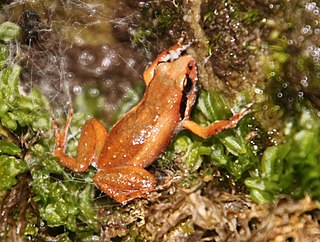
Arthroleptella is a genus of frogs known as moss frogs in the family Pyxicephalidae. The ten species of this genus are endemic to South Africa.
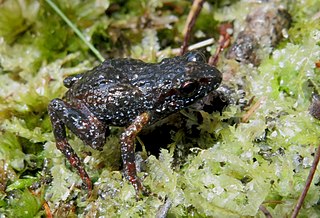
The Drewes' moss frog is a species of frog in the family Pyxicephalidae. It is endemic to Fernkloof Nature Reserve & nearby surroundings in South Africa. Its natural habitats are Mediterranean-type shrubby vegetation and rivers. It is threatened by habitat loss.
The Landdros moss frog is a species of frog in the family Pyxicephalidae.

Lightfoot's moss frog or the Cape Peninsula moss frog is a species of frog in the family Pyxicephalidae. It is endemic to South Africa. Its natural habitats are temperate forest, Mediterranean-type shrubby vegetation, and rivers. It is threatened by habitat loss.

Anhydrophryne ngongoniensis, the Ngongoni moss frog, Natal bandit frog, or mistbelt chirping frog, is a species of frog in the family Pyxicephalidae. It is endemic to South Africa.

Arthroleptella subvoce is a species of frogs in the family Pyxicephalidae. It is endemic to South Africa and only known from the Groot Winterhoek Wilderness Area, Western Cape. Common name northern moss frog has been coined for it. The specific name subvoce is Latin for "under voice" and refers to the very subdued male advertisement call of this frog.

The De Villiers' moss frog is a minute species of frog in the family Pyxicephalidae, which is endemic to the Western Cape, South Africa. At around 22 mm (0.87 in) length, it is one of the smallest regional species, though larger than the micro frog.
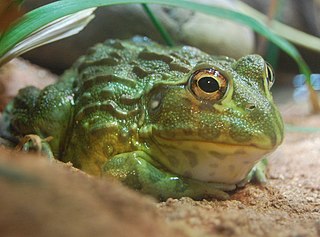
The Pyxicephalidae are a family of frogs currently found in sub-Saharan Africa. However, in the Eocene, the taxon Thaumastosaurus lived in Europe.
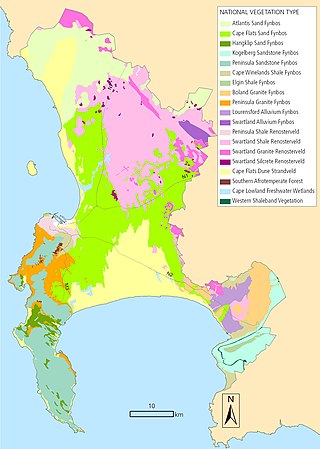
The Biodiversity of Cape Town is the variety and variability of life within the geographical extent of the City of Cape Town metropolitan municipality, excluding the Prince Edward Islands. The terrestrial vegetation is particularly diverse and much of it is endemic to the city and its vicinity. Terrestrial and freshwater animal life is heavily impacted by urban development and habitat degradation. Marine life of the waters immediately adjacent to the city along the Cape Peninsula and in False Bay is also diverse, and while also impacted by human activity, the habitats are relatively intact.

Anhydrophryne is a genus of frogs in the family Pyxicephalidae, formerly in Petropedetidae. It is endemic to South Africa. Until recently, the genus was monotypic, containing only Anhydrophryne rattrayi, until it absorbed two more species formerly classified as belonging to genus Arthroleptella.
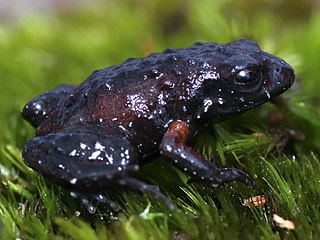
Arthroleptella rugosa is a species of frog in the family Pyxicephalidae. It is endemic to South Africa and only known from the Klein Swartberg Mountain, an inselberg near Caledon, Western Cape. The specific name rugosa is Latin for wrinkled or rough and refers to the rough appearance of this species as well as its rough sounding advertisement call. Accordingly, the common name rough moss frog has been suggested for it.

The Riviersonderent moss frog is a species of frog in the family Pyxicephalidae.It is endemic to Riviersonderend Mountains and nearby surround in South Africa.

The Drakenstein moss frog is a species of frog in the family Pyxicephalidae. It is endemic to Drakenstein mountain and nearby in South Africa.















